I first read about the Strong Heel in a discussion a few years ago on the Socknitters Group on Yahoo. As I love to try different ways of knitting heels, I thought it would be fun to try this one. The Strong Heel is named after the lady who designed the heel Gerdine Crawford-Strong. The heel technique was first published in Knitter’s Magazine, Fall 2003, Issue 72. This issue seems impossible to find.
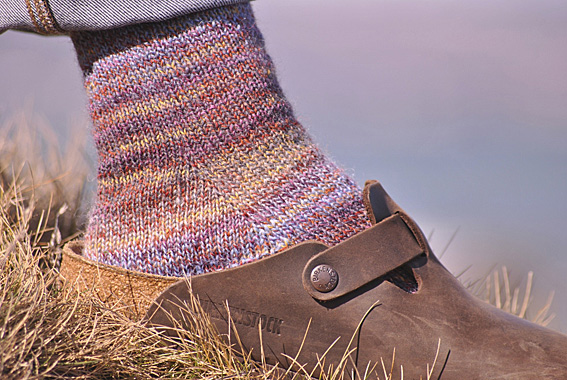
Later I read the pattern Uzu by Mary the Hobbit published in the online magazine Knitty. On reading this I was a little disappointed to find it was a toe up pattern and I wanted cuff down instructions for this heel. Continuing my search, I found the clearly written instructions Easier Socks with the Strong Heel by Aaron Clark. These instructions were written for Fibre Camp Boston where he taught a class.
I love knitting socks, but hate picking up stitches for the heel. This is my favorite heel because of its simplicity, requiring no picking up. Presentation will include hands-on possibilities for those who bring their projects. – Aaron Clark
I was delighted to find his clearly written instructions for the heel. The instructions are for a cuff down sock which was exactly what I was looking for.
There are a few interesting points that I have noted in my journal while knitting this heel. When knitting this heel I noted that it is indeed, a wonderfully easy heel to knit, once started you don’t even need to keep counting.
In the main, it was how the heel looked as I was knitting it and how the finished sock felt when I was wearing it that I made notes on.
I find my socks knit using the strong heel, I have made (5 pairs+ at this point), to be comfortable to wear. I have diabetes and this sock construction and heel is very smooth with no lumps and bumps to rub against my foot. I have a couple of provisos regarding the strong heel though. It is not as structured in fit, perhaps because, in comparison to the slip stitched heel flap, which I think helps give the heel structure, this heel can twist a little when I am wearing them. The heel also feels a little ‘slouchier’ around the ankle. For this reason, I wouldn’t use a cotton or cotton rich sock yarn to knit a sock with the Strong Heel. I think it works best with a wool or wool/nylon sock yarn which has a bit more ‘elasticity’ to it. I have wondered if this could be improved if I was to work an area in the centre of the heel using slip stitch I usually use on the heel flap. I shall experiment with that.
Where the heel really comes into its own is when you want to continue the patterning down the back of the heel and across the foot, when knitting a Fair Isle sock. I used this when I was knitting my Broken Fair Isle Stripe Socks and adore the result.
You do get used to where you expect to see the ‘gusset shaping’ on a sock. With the Strong heel the ‘heel flap’ and ‘gusset shaping’ are worked at the same time, then the heel is turned using short rows. This is an easy process to work, but the sock just looks different. When I showed off some of my socks sporting the Strong Heel at Christmas, I to my mum and sister, there subdued reaction, made me glad that I had knit their Christmas sock presents using the heel flap that they are used to receiving from me. Personally, I like how they look. I love that they are a bit different.
For myself, I like wearing my socks with the strong heel. I find them more comfortable than the short row or afterthought heels and when there is a sudden need for replacing socks in my sock drawer, quicker to knit than the heel flap/gusset heel. So there will always be a place for this heel style in my sock drawer and I know I will knit more of them.
I have washed and worn socks using this heel construction many times since discovering the Strong Heel construction and continue to be pleased with the socks made using this method.
Heather Socks Featuring the Strong Heel
- I used a 100g ball of Wendy Roam Fusion in colour 2020 for knitting this pair of socks. My pair of socks used 65g of yarn.
- A set of 5 double pointed needles in size 2.75mm
- I used a set of 5 double pointed needles in size 2.5mm for knitting the toes.
It can be very hard to improve upon a basic pair of plain socks for wearing on a day to day basis.
- I cast on 60 stitches spread over 4 needles and worked 15 rounds of knit 1, purl 1 rib.
- Then I worked 47 rounds of stocking stitch for the leg (all rounds knit).
Then I started the Strong Heel.
Strong Heel
Needles 1 and 2: Are the Instep stitches
Needles 3 and 4: Heel and gusset stitches – these are the needles on which the increasing takes place.
- Round 1: Needles 1 & 2: k; Needle 3: k1, m1, k to end of needle; Needle 4: k to last stitch, m1, k1
- Round 2: Needles 1 & 2: k; Needle 3 & 4: k
- Repeat rounds 1 and 2 until needles 3 and 4 each have 28 stitches on them.
Heel Turn
Turn work to begin heel turn on a wrong side row. Only working on Needles 3 and 4.
- Row 1: Needle 4: sl1, p to end of needle; Needle 3: p1, p2tog, p1, turn
- Row 2: sl1, k3, ssk, k1, turn
- Note that there will be a small gap between the working stitches that form the heel turn and the unworked heel stitches.
- Row 3: sl1, purl to within 1 st of gap, p2tog, p1, turn
- Row 4: sl1, knit to within 1 st of gap, ssk, k1, turn
- Repeat rows 3 and 4 until all side stitches have been worked, and there are 15 stitches on needle 3 and 15 stitches on needle 4. Should end on a completed row 4.
Then continue knitting the foot of the sock as normal. I knit 40 rounds for the foot.
Toe
I did the paired decrease toe. Starting with a decrease row and using the 2.5mm needles.
- Round 1 is the decrease round for shaping: Needle 1, k to last 3 sts then k2tog, k1; Needle 2, k1, ssk, k to end of needle; Needle 3, k to last 3 sts, then k2tog, k1; Needle 4, k1, ssk, knit to the end of needle.
- Rounds 2, 3 and 4: Knit
- Round 5: Repeat round 1 the decrease round
- Rounds 6 and 7: Knit
- Rounds 8 to 10: Repeat round 5, 6 and 7 once
- Rounds 11: Repeat round 1 the decrease round
- Round 12: Knit
- Round 13, 14, 15 and 16: Repeat rounds 11 and 12 two times.
- From round 17 work the decrease round on every round until there are 2 stitches on each needle. Next slide the stitches from Needle 2 onto Needle 1, and the stitches from Needle 4 onto Needle 3.
I used kitchener stitch (these instructions by Theresa Vinson Stenersen for Knitty are wonderful) to graft the toe stitches together.
A comfortable warm pair of basic and very quick to knit socks. The Strong Heel is easy to knit as it requires no picking up of stitches and the knitting of the sock flows very smoothly from the ribbed cuff to the grafting of the toe.

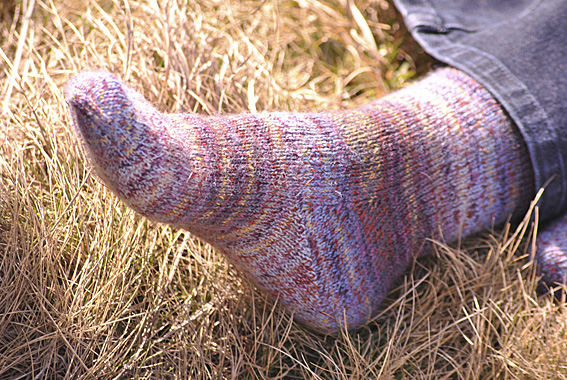
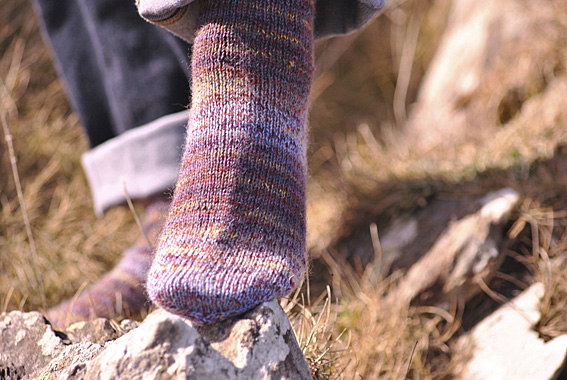
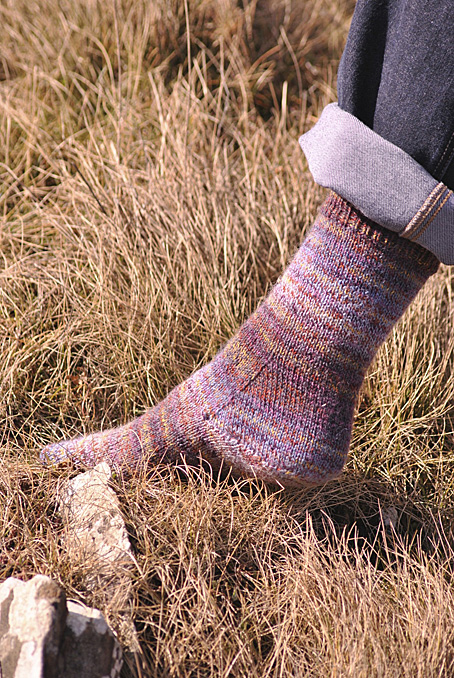
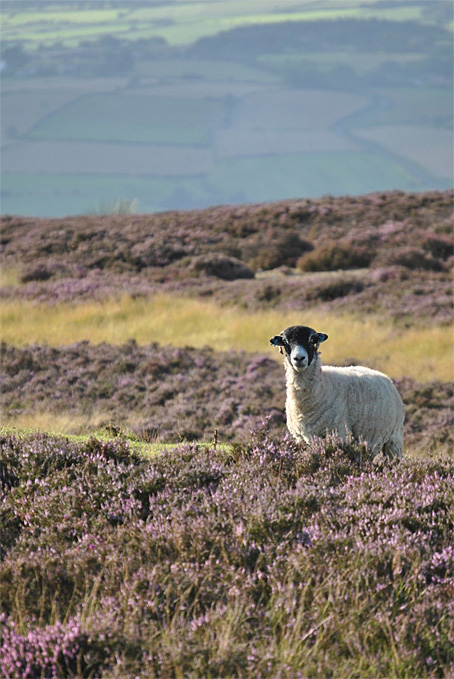
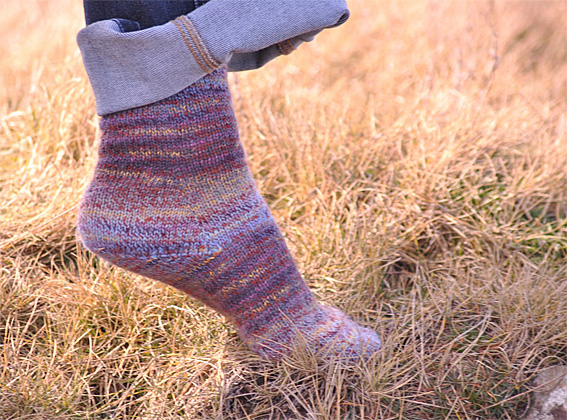
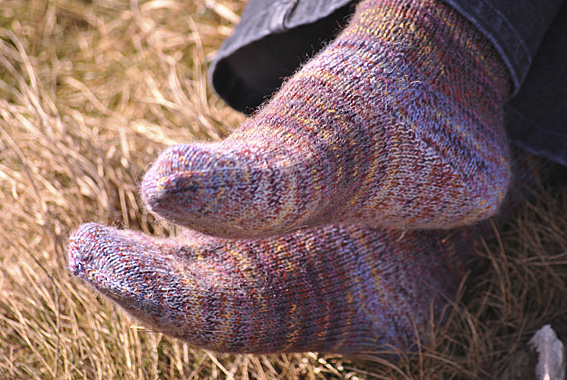
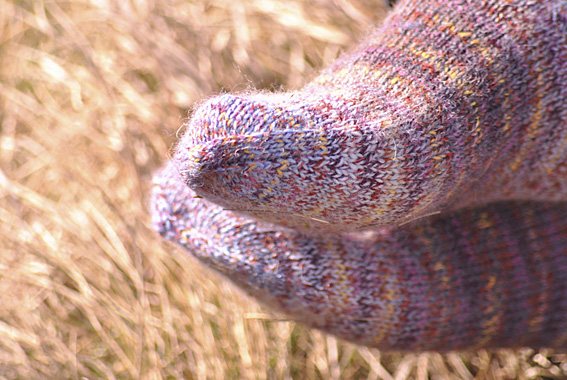
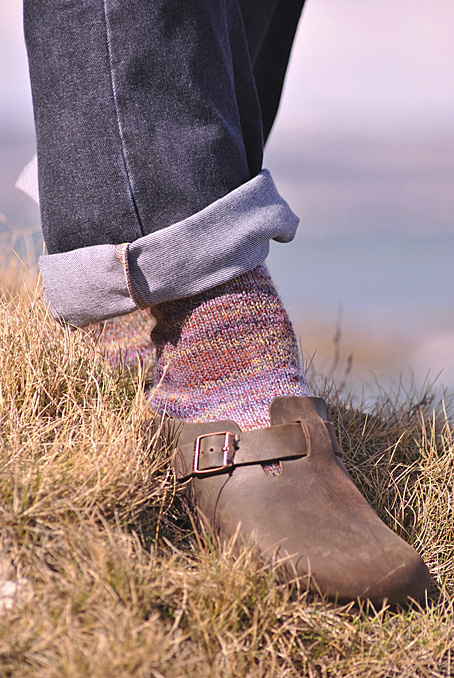


Hello
I have been looking for help on this heel. This is great! One question: Where do you do the M1L and M1R?
Pattern just says M1. I’d appreciate your help. thank you so much.
Rebecca Slark
Hi,
When you M1 do you knit 1stitch front and back, M1L, M1R or do a yo and knit in the back loop on the next row?
Thank-you for your lovely pattern.
Linda
Hi Linda, Sorry not to reply sooner, I broke my right ankle and right wrist in January. In answer to your question I normally do a M1L and M1R. Happy Knitting, Nicolette
Oh dear, I’m so sorry to hear about your ankle and wrist, good gosh that must be just awful.
I’m glad I waited to hear from you though. Someone told me to make the first stitch right. M1R and the second one M1L. I’m just not too used of making socks yet and sometimes the brain just can’t get around something that seems so easy to others.
Thank-you so much Nicolette and I hope you heal quickly.
Kindest regards,
Linda
Thank you Linda, much appreciated.
Hi Nicolette, I’m a fairly new knitter and love your sock patterns. I’ve knit one sock using the Strong heel pattern and discovered that when I knit the toe the shaping goes down the middle of the toes instead along the top. I’ll adjust this when I knit sock #2. I notice that no one else has mentioned this and am wondering if I’ve misread the pattern? Thanks!
I’ve had a couple of questions about the shaping of the Strong Heel but the last time I knit the pattern was in 2016 for the Sweet & Spicy Saffron Socks so I’ll reknit the pattern and see if any issues jump out at me.
Hi Nicolette,
Thanks for the pattern.
I like this heel, but I have a couple of questions about it: you work on 60 sts (that is 15 sts per needle) and you increase until you have 28 sts (i.e. you increase 13 sts per needle). Is that a standard increase for socks? I mean: if you work on 60 sts you have to increase x sts for the heel?
I thought that if you work with, for example 15 sts per needle you have to increase 15 for the heels. Does it make sense or am I totally wrong?
Thanks in advance,
Gaby
I’ve had a couple of questions about the shaping of the Strong Heel but the last time I knit the pattern was in 2016 for the Sweet & Spicy Saffron Socks so I’ll reknit the pattern and see if any issues jump out at me.
Hi Nicolette, just reading about the Strong heel. What about using magic loop? Using 5 needles is way to much. I’m new to making socks and actually knitting. Looking forward to your reply.
I just signed up for your newsletter.
Hi Jeanne
I’m sure you could use magic loop by putting instep stitches on one needle and the heel stitches on the other. I can’t give advice though as magic loop isn’t a technique that I use. Sorry I can’t be more helpful. Happy knitting, Nicolette
Hi Linda! I don’t yet know if I can post the comment but I try. These are most amazing socks I’ve seen so far. I love this heel! It will remain my favorite. I started searching for different types of heel as the gusset and flap one was my fav until now but too much work picking new stitches. Why nobody talks about this one? I am watching trillions of podcasts and nothing. Thank you!
Any way to adapt to 4 needles? I’ve tried using 5 but I’m so clumpsy.
Hi everyone, I have found a really good strong sock heel pattern from jooles hill , she calls it her godet heel , Its really good for both toe up and top down socks , I just followed the same instructions for both ways , her pattern is on Ravelry under the name sweet bee socks , jooles user name is sew sweet violet. Here is a link to her pattern.
https://www.ravelry.com/patterns/library/sweet-bee-socks
The name Strong heel refers to Geraldine Crawford Strong….not the strength of the heel.
My favorite heel is the Cat Bordhi Sweet Tomato Heel which also has no heel flap/gussett and no picking up stitches. I am curious to hear from anyone who has made both the Strong Heel and the ST Heel as to how they compare in ease of knitting and comfort in wearing.
Can u use this with magic loop?
I’m sure you could, but I’m not proficient in knitting with magic loop, so I can’t offer any advice. Perhaps someone else could help? I’m assuming that the 30 instep stitches would be on one needle and the strong heel shaping stitches would be on the other and that you would use stitch markers to track the shaping?
Hi, this is very similar to the fleege heel technique. You can certainly knit this magic loop. I do it all of the time. Your instep stitches are one needle, sole stitches on the other. You work across the instep, then start your increases on the sole. Next round, knit all around without increasing. Continue until you get the number of stitches for your gussett, per pattern. Then you just work on the sole of the heel, back and forth to do the heel turn. If you are working two at a time, magic loop, the gussett increases can be worked on both socks. Once you start the heel turn, you will have to only turn one heel at a time. Good luck. this is my favorite technique for the heel. It fits better for most people.
I am so frustrated! I don’t understand your pattern.
“Row 1: Needle 4: sl1, p to end of needle; Needle 3: p1, p2tog, p1, turn
Row 2: sl1, k3, ssk, k1, turn”
That means there is only 3 stitches on your needle, from #3. So where do you get all the extra stitches to do row 2? I thought maybe you go into needle #4, but then the next instruction make no sense.
“Row 3: sl1, purl to within 1 st of gap, p2tog, p1, turn”
After the S1 is the gap!
Hi Sue
On Row 2: you do go into the stitches on needle 4. Then you turn the work to work back.
When you do the p2tog and the ssk you will find that there is a gap between them and the next stitch on the needle. That is the “gap” that I am talking about. Your future p2tog and ssk will close this “gap” so you don’t have a hole showing along the shaping.
I hope that helps. Nicolette
If you look at my last line, you will see my problem with that.
Thank you for responding, by I already pulled it out to do the heel flap that I already know.
Hi Sue Prewitt, you get a gap on both the purl and knit rows-at the end of each row, just before you turn the work to go back the other way. First time I’ve tried this heel and I think it looks great!
Hi, I love the strong heel, has anyone tried to knit it knit1, slip1 to make it a bit less loose?
Hi, Personally, I haven’t, but I’d love to hear if anyone else has.
Hi Nicolette, I love your website and all of your patterns. I am a fairly experienced knitter, but have only been making socks for a few months, trying a different technique or pattern with each one. I was successful with the Strong Heel, however, I have one question. When turning the heel, using needles 3 and 4, do you knit with a 3rd DPN? I started and found it easier to just knit back and forth on 3 and 4, then redistribute my stitches at the end. My heel looks like the picture so i wasn’t worried, just curious. Thanks
Just stumbled across this, and it’s inspired me to have a go at this heel, adapting it for my usual 72 stitch cuff-down socks (although it will have to wait a little until my current pair is off the needles). I’ll let you know how it goes (and blog about it and link yours, if that’s okay?)
DancingMoth
Do let me know when you’ve finished. I’d love to read your post.
My post languished in draft for a ridiculous amount of time, during which I wore and washed the socks several times, forgot to photograph them and misplaced my design notebook. The latter now unearthed, the post finished (but backdated to when I took the photo), https://dancingmoth.blogspot.com/2018/02/strong-heel-socks.html
They are beautiful!! How sturdy is the heel, or will I need to find a way to reinforce it? I am VERY hard on my socks, especially in the heel.
I’ve found that the heel has worn well for me. But I tend to wear through the toes on my socks which is partly why I knit from the cuff to the toe. It makes it easier to unravel the toe and re-knit it. I haven’t tried it, but I don’t see why you couldn’t work a panel of slip stitching like in the normal heel flap on the centre of the heel. Happy Knitting, Nicolette
Nicolette, I use a reinforcing thread in the toes. I start at the decrease and then only use it in the rows without a decrease, otherwise it gets a little bulky. I have not worn through a toe since I started using the thread.
Thanks for the suggestion Karen. I’ve never used a reinforcing thread when knitting my socks. Do you find it makes any difference to the comfort of the sock when you’re wearing it? Nicolette
I’ve used reinforcement thread on my heels, it’s a little more padded / thick than a normal heel. It would be possible to do on a Strong heel for just the heel turn. Thanks for a lovely post about the Strong heel. It’s one of my favorite heels for stripes
Thanks for this pattern – can’t wait to try it.!
Hi Linda, I am sure you will love these socks. I am wearing them today and they are very comfortable. Thank you for leaving a comment. Happy Knitting.